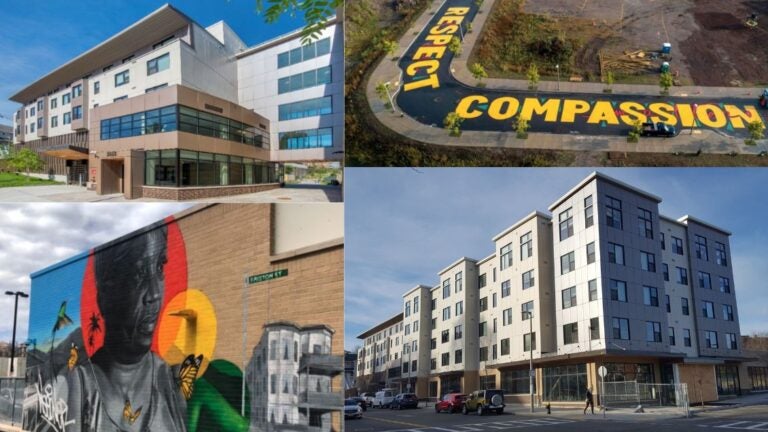Newsletter Signup
Stay up to date on all the latest news from Boston.com

In the heart of Roxbury near Nubian Square, an 8.5-acre former MBTA bus yard sat unused for decades. The land was polluted with industrial chemicals and waste, and the decaying buildings were filled with asbestos and lead paint. In the early 2000s, two local developers joined forces to begin the herculean effort of tearing it down, cleaning it up, and building something new.
Almost 20 years later, that “something new” has a name: Bartlett Station.
Bartlett Station is a mixed-use development with 382 housing units, plus retail and commercial space for Roxbury businesses. When it’s finished, it will comprise ten different buildings connected by green space, including a public lawn and an outdoor events space. There will be affordable senior housing, a gallery filled with local art, and a community gathering space.
After years of planning and financing, construction is picking up speed. Three of the buildings are complete and filled with tenants. The rest are scheduled to open by 2025. Three businesses have moved into the commercial space on Washington Street: a gym, a Montessori preschool, and Nubian Markets, a locally-owned market-slash-café.
On the residential side, Bartlett Station uses a mixed-income model. One third of the units are priced affordably, one third moderately, and one third market-rate. The goal is to offer high-quality housing without gentrifying the neighborhood.
Roxbury has not been immune to Boston’s housing availability and affordability crisis. And as a majority-Black and Hispanic community where the median income is much lower than the city’s overall ($27,700 compared to $62,000, in 2019), residents often feel their needs have been ignored when it comes to housing and economic investment.
“The community has always gotten a lot of promises, and seldom are those promises met,” said Arnold Johnson, who grew up in Roxbury and runs Windale Development alongside his business partner George Chin. “A lot of times, when you’re living in a community, things just happen. A building will be built. Nobody that looks like the residents will be working on it. And that’s the way it is.”
What makes Bartlett Station different is that it’s been designed for and by the community. The developers, Windale Development and Nuestra Comunidad, are both Roxbury-based. Their work is guided by input from neighbors and residents on the Project Review Committee, a group that monitors Bartlett’s progress and ensures it stays true to its vision: a sustainable “urban village” where Roxbury residents from all walks of life can live, work, play, and grow.
The story of Bartlett Station begins in 2001, when Mayor Tom Menino’s administration and the Boston Redevelopment Authority began working with local residents to draft the Roxbury Strategic Master Plan — a comprehensive plan to boost Roxbury’s economy, civic infrastructure, and housing stock. The document they produced in 2004 called for unused, empty land throughout the neighborhood to be turned into new housing that fit Roxbury’s historical character, employed community members during the development process, and contained a combination of affordable and market-priced units.
The deteriorating Bartlett bus yard was a perfect candidate for this type of redevelopment. In 2006, the Boston Redevelopment Authority and the MBTA put the parcel up for sale, on the condition that the buyers uphold the principles of the Roxbury Master Plan and build something that would generate wealth and opportunities for the community. Windale and Nuestra bid on the project together and were awarded the contract in 2010. They spent the next few years cleaning up the site, receiving multiple grants from the Environmental Protection Agency.
The developers finally broke ground on Bartlett Station in 2017. Since then, three buildings have been completed containing 14 market-rate homeownership units, two income-restricted homeownership units, 98 affordable rentals, and 22 market-rate rentals. Fifty affordable rental units for seniors in a fourth building called “The Kenzi” — a partnership with the nonprofit developer POAH, or Preservation of Affordable Housing — are slated for completion by the end of the year. Three more buildings and the public park, known as “Oasis@Bartlett,” have gone through the city’s permitting process and are in various stages of planning and construction. Three more are in the design and permitting phase. All of the buildings will contain a mix of affordable, moderately-priced, and market-rate rental and ownership units.
Why has it taken so long? First, it took time to gather community input on the Roxbury Master Plan, find a buyer for the bus yard, and agree on how the land would be developed. Before the developers could begin building, they had to raise money — and lots of it — because affordably-priced units don’t pay for themselves over time the way market-priced units do.
Construction is particularly costly when it’s sustainable and uses high-quality materials. All of the Bartlett buildings are designed to meet LEED’s gold standard, at a minimum. And Nuestra and Windale aren’t cutting corners on materials or square footage in their affordable units the way other developers might, according to Chin.
Bartlett’s approach to affordable housing that is livable and pleasant costs more up front, but it pays in other ways. When families have room to live comfortably, “it doesn’t just stabilize that household,” Jones said. “It stabilizes the neighborhood.”
Where does the money come from? Nuestra and Windale are small, local operations. Nuestra is a nonprofit, and although Windale is technically a for-profit company, Chin and Johnson say its margins are razor-thin. Bank of America’s Community Development Company was supposed to be a financing partner, but backed out after the 2008 financial crisis plunged the country into a recession. The developers are partially relying on profits from the market-rate housing to offset the cost of the affordable units. The rest of their funding comes from city and state grants.
Bartlett’s two primary funders are the Mayor’s Office of Housing and the Massachusetts Executive Office of Housing and Livable Communities (formerly the Department of Housing and Community Development). Each office conducts one round of funding per year, and the developers have to apply separately for each building. The grants are competitive, and if the developers don’t get chosen for a funding round, they have to wait a year to reapply.
Money aside, the zoning and permitting process is complicated and time-consuming — especially for affordable housing, for which there are extra rules.
“[Mayor Michelle Wu] is really working hard to streamline the process,” said Andre Jones, director of community engagement at Nuestra Comunidad. “But it takes a long time just to get a project. There’s a lot of scrutiny.” For instance, Jones said it took a year and a half to get one of Bartlett’s building designs approved by the city after an initial meeting where officials said they liked the design.
Another reason this project has taken decades to realize is that gathering and implementing community input is a slow process — sometimes frustratingly slow.
“Sometimes it’s a challenge, because you have people that start with the process, but then their interests change, and they move on to something different, so they no longer participate,” explained Michael Miles, a Roxbury resident and longtime member of the Bartlett Station Project Review Committee. “In comes a new volunteer who’ll say, ‘Oh, yeah, I’d like to participate,’ and then they have a whole other set of ideas and things that they want to see … Sometimes you would have to go three steps back, and then come forward again.”
Regardless, Miles said, getting the neighborhood perspective has been crucial to keeping Bartlett Station on track. Residents nixed the idea of putting a big-box store in the commercial space because it didn’t align with their goals of supporting local businesses. They advocated for the public park, the art gallery, and more spacious units. Under advisement from the community, Windale and Nuestra employ at least 60% people of color, 40% Roxbury residents, and 12% women at their worksites.
“You have families, you have working professionals, you have socio-economic income ranges, and then you have seniors mingling in as well,” Miles said. “It just brings the entire Roxbury family together, in a way.”
Some community requests are more actionable than others. Neighbors have told the developers that they want a sit-down restaurant, preferably locally owned, in Bartlett’s corner commercial space. Finding that tenant has been challenging.
“We had a possible local restaurateur interested in this space … well, that entrepreneur got an offer they couldn’t refuse in the Seaport,” Jones said. The search continues.
Bartlett is by no means the only affordable or mixed-income housing development in Boston. The Mayor’s Office of Housing is constantly financing new income-restricted housing in the city, and maintains a public database of currently-available units.
Still, Bartlett Station demonstrates that building high-quality housing is an expensive, slow process. Bartlett’s affordable ownership units will be sold at a loss that’s just barely made up by outside grants. The developers aren’t in this for the money. Why have they stuck it out through all the setbacks, bureaucratic red tape, and a recession?
“You could say we’re suckers,” Johnson laughed. Jokes aside, he said, Roxbury has a housing crisis. Who better to tackle it than people from within the community, with a stake in its success?
He added that for every success story like Bartlett Station, numerous other development projects will stall and be shelved. The 2004 Roxbury Master Plan identified several empty lots for redevelopment, but some of them — like the publicly-owned Parcel P3 near Nubian Square — remain vacant to this day.
Whether a large-scale affordable housing development fails or succeeds in Boston is largely dependent on the tenacity of the developers and the community members advising them.
Miles wishes that weren’t the case. Between the complicated financing, zoning, and permitting processes, “it’s a major challenge, systemically,” he said. “But we keep hope alive.”
Stay up to date on all the latest news from Boston.com

Stay up to date with everything Boston. Receive the latest news and breaking updates, straight from our newsroom to your inbox.
Conversation
This discussion has ended. Please join elsewhere on Boston.com